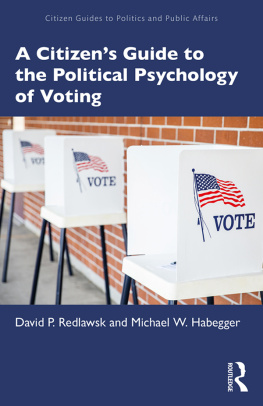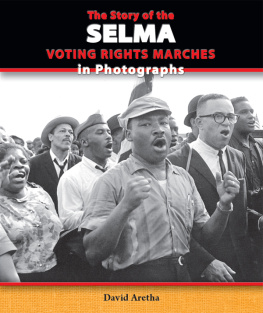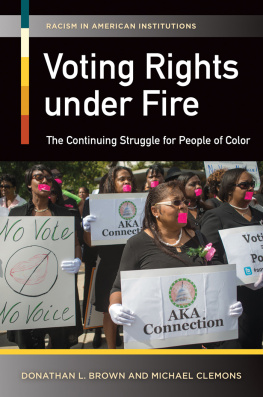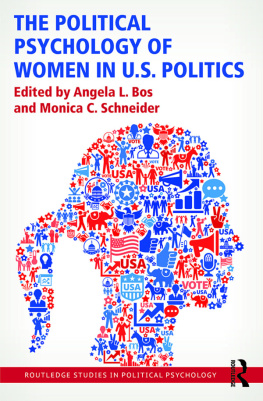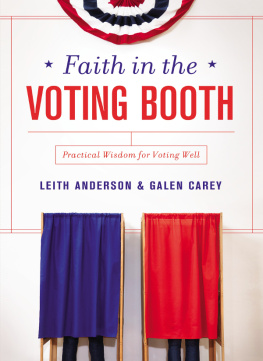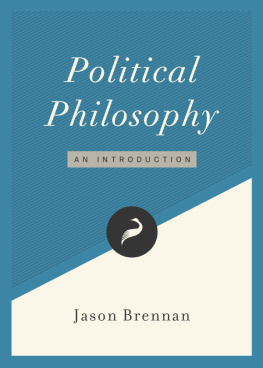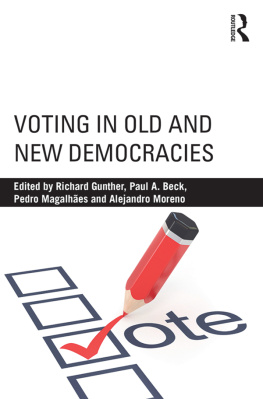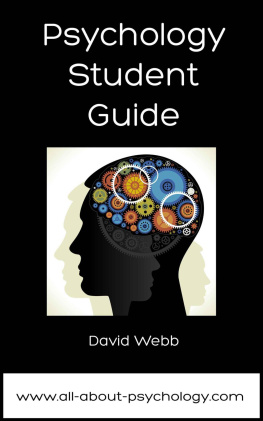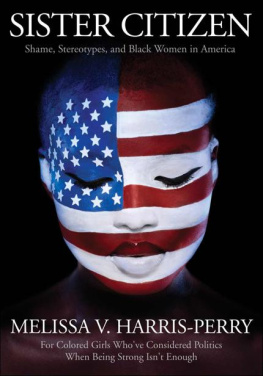A Citizens Guide to the Political Psychology of Voting
In the run-up to a contentious 2020 presidential election, the much-maligned American voter may indeed be wondering, How did we get here? A Citizens Guide to the Political Psychology of Voting offers a way of thinking about how voters make decisions that provides both hope and concern. In many ways, voters may be able to effectively process vast amounts of information in order to decide which candidates to vote for in concert with their ideas, values, and priorities. But human limitations in information processing must give us pause. While we all might think we want to be rational information processors, political psychologists recognize that most of the time we do not have the time or the motivation to do so. The question is, can voters do a good enough job even if they fail to account for everything during the campaign? Evidence suggests that they can, but it isnt easy. Here, Redlawsk and Habegger portray a wide variety of voter styles and approachesfrom the most motivated and engaged to the farthest removed and disenchantedin vignettes that connect the long tradition of voter survey research to real life voting challenges. They explore how voters search for political information and make use of it in evaluating candidates and their positions. Ultimately, they find that American voters are reasonably competent in making well-enough informed vote choices efficiently and responsibly. For citizen voters as well as students and scholars, these results should encourage regular turnout for elections now and in the future.
David P. Redlawsk is James R. Soles Professor and Chair of the Department of Political Science and International Relations at the University of Delaware. He previously taught at Rutgers and the University of Iowa. He has many years of practical political experience, having lost and won elections for local office in New Jersey, and led a county party organization in Iowa, organizing the countys Iowa Caucuses for 2004.
Michael W. Habegger is an instructor and Ph.D. candidate in the Department of Political Science & International Relations at the University of Delaware and serves as the Editorial Assistant for the International Journal of Public Opinion Research. His research lies at the intersection of democracy and the Internet, broadly, and social media practices and the concepts of subjectivity and the public sphere, specifically.
Citizen Guides to Politics and Public Affairs
Morgan Marietta and Bert Rockman, Series Editors
Each book in this series is framed around a significant but not well-understood subject that is integral to citizensboth students and the general publicfull understanding of politics and participation in public affairs. In accessible language, these titles provide readers with the tools for understanding the root issues in political life. Individual volumes are brief and engaging, written in short, readable chapters without extensive citations or footnoting. Together they are part of an essential library to equip us all for fuller engagement with the issues of our times.
Titles in the series:
A Citizens Guide to the Constitution and the Supreme Court
Constitutional Conflict in American Politics
Morgan Marietta
A Citizens Guide to American Foreign Policy
Tragic Choices and the Limits of Rationality
David Patrick Houghton
A Citizens Guide to Federal Deficits and Debt
The Politics of Taxing, Spending and Borrowing
William E. Hudson
A Citizens Guide to Terrorism and Counterterrorism
Christopher C. Harmon
A Citizens Guide to Presidential Nominations
The Competition for Leadership
Wayne P. Steger
A Citizens Guide to U.S. Elections
Empowering Democracy in America
Costas Panagopoulos and Aaron C. Weinschenk
A Citizens Guide to the Political Psychology of Voting
David P. Redlawsk and Michael W. Habegger
First published 2020
by Routledge
52 Vanderbilt Avenue, New York, NY 10017
and by Routledge
2 Park Square, Milton Park, Abingdon, Oxon, OX14 4RN
Routledge is an imprint of the Taylor & Francis Group, an informa business
2020 Taylor & Francis
The right of David P. Redlawsk and Michael W. Habegger to be identified as authors of this work has been asserted by them in accordance with sections 77 and 78 of the Copyright, Designs and Patents Act 1988.
All rights reserved. No part of this book may be reprinted or reproduced or utilised in any form or by any electronic, mechanical, or other means, now known or hereafter invented, including photocopying and recording, or in any information storage or retrieval system, without permission in writing from the publishers.
Trademark notice: Product or corporate names may be trademarks or registered trademarks, and are used only for identification and explanation without intent to infringe.
Library of Congress Cataloging-in-Publication Data
A catalog record for this title has been requested
ISBN: 978-1-138-19398-7 (hbk)
ISBN: 978-1-138-19399-4 (pbk)
ISBN: 978-1-315-63905-5 (ebk)
Typeset in Sabon
by Newgen Publishing UK
Contents
Perhaps the first sign that Hillary Clintons 2016 presidential campaign was more uncertain about the outcome than they let on came just a day before the election, when the campaign cancelled its celebratory fireworks over New York Citys Hudson River. No official announcement was made, and in the frenzy of nearly unanimous agreement among pundits and polls that she would be elected the first woman president, a simple NBC News report was little noticed.
As we all now know, the November 8, 2016 presidential election resulted in a shock to those same pundits and pollsters, when Donald J. Trump bested Clinton in the Electoral College to win the presidency. He eked out his win by the narrowest of margins in three key states: Wisconsin, Michigan, and Pennsylvania, as well as taking a number of other toss-up states. Despite winning about 2.9 million more votes than Trump, Clinton was relegated to the spectator seats next to former president Bill Clinton as Trump was sworn in on January 20, 2017.
Every time there is an election, there are winners and there are losers. And there are the voters who get to make that choice. The purpose of this book is less to talk about any specific electioneven the election of 2016than it is to try to understand the voters who make these decisions. Election campaigns are complicated, multi-player games, with campaigns devising and revising strategies, responding to opponents, and reaching out in both obvious and hidden ways to voters. There is much to be said about campaign strategies and about why Donald Trump won his Electoral College victory while Hillary Clinton bested him in the popular vote.
But our intuition is that most of what is written in the coming years will teach us that voting behavior in 2016 was not particularly unique, or even all that odd. While no one can argue that the outcome was expected, or that the information environment did not have some unusual elements, votersas human beingshavent changed just because the 2016 campaign might have been extraordinary. Our plan here, then, is to focus on voters; how they use information to evaluate candidates and make their decisions, how they think and feel about politics, and how they do so within an information environment defined by the campaigns.


